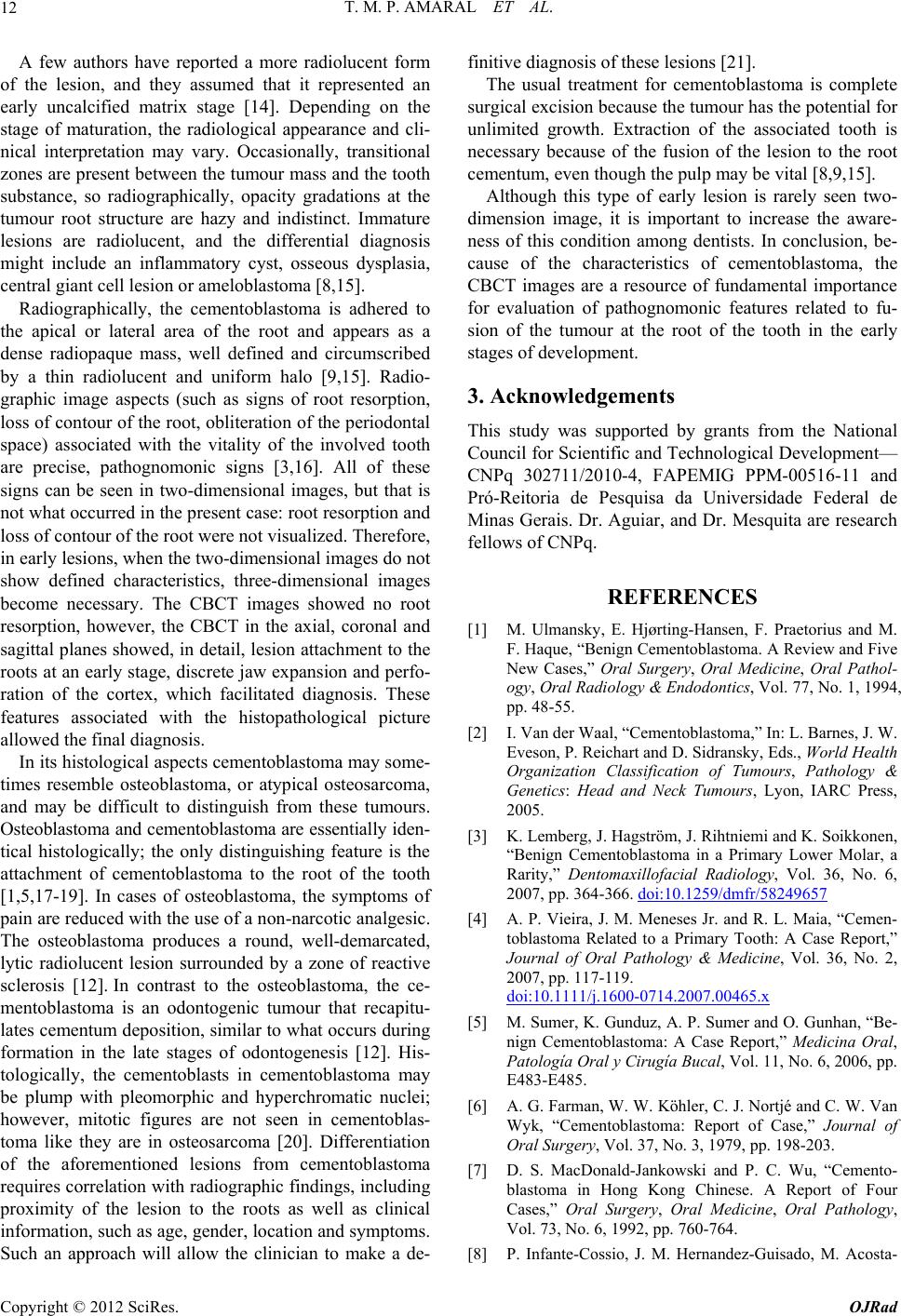
T. M. P. AMARAL ET AL.
12
A few authors have reported a more radiolucent form
of the lesion, and they assumed that it represented an
early uncalcified matrix stage [14]. Depending on the
stage of maturation, the radiological appearance and cli-
nical interpretation may vary. Occasionally, transitional
zones are present between the tumour mass and the tooth
substance, so radiographically, opacity gradations at the
tumour root structure are hazy and indistinct. Immature
lesions are radiolucent, and the differential diagnosis
might include an inflammatory cyst, osseous dysplasia,
central giant cell lesion or ameloblastom a [8,15].
Radiographically, the cementoblastoma is adhered to
the apical or lateral area of the root and appears as a
dense radiopaque mass, well defined and circumscribed
by a thin radiolucent and uniform halo [9,15]. Radio-
graphic image aspects (such as signs of root resorption,
loss of contour of the root, obliteration of the periodon tal
space) associated with the vitality of the involved tooth
are precise, pathognomonic signs [3,16]. All of these
signs can be seen in two-dimensional images, but that is
not what occurred in the present case: root resorption and
loss of contour of the root were not visualized. Therefore,
in early lesions, when the two-dimensional images d o not
show defined characteristics, three-dimensional images
become necessary. The CBCT images showed no root
resorption, however, the CBCT in the axial, coronal and
sagittal planes showed, in detail, lesion attach ment to the
roots at an early stage, discrete jaw expansion and perfo-
ration of the cortex, which facilitated diagnosis. These
features associated with the histopathological picture
allowed the final diagnosis.
In its histological aspects cementoblastoma may some-
times resemble osteoblastoma, or atypical osteosarcoma,
and may be difficult to distinguish from these tumours.
Osteoblastoma and cementoblastoma are essentially iden-
tical histologically; the only distinguishing feature is the
attachment of cementoblastoma to the root of the tooth
[1,5,17-19]. In cases of osteoblastoma, the symptoms of
pain are reduced with the use of a non-narcotic analgesic.
The osteoblastoma produces a round, well-demarcated,
lytic radiolucent lesion surrounded by a zone of reactive
sclerosis [12]. In contrast to the osteoblastoma, the ce-
mentoblastoma is an odontogenic tumour that recapitu-
lates cementum deposition, similar to what occurs during
formation in the late stages of odontogenesis [12]. His-
tologically, the cementoblasts in cementoblastoma may
be plump with pleomorphic and hyperchromatic nuclei;
however, mitotic figures are not seen in cementoblas-
toma like they are in osteosarcoma [20]. Differentiation
of the aforementioned lesions from cementoblastoma
requires correlation with radiographic findings, including
proximity of the lesion to the roots as well as clinical
information, such as age, gender, location and symptoms.
Such an approach will allow the clinician to make a de-
finitive diagnosis of these lesions [21].
The usual treatment for cementoblastoma is complete
surgical excision because the tumour has the potential for
unlimited growth. Extraction of the associated tooth is
necessary because of the fusion of the lesion to the root
cementum, even though the pulp may be vital [8,9,15].
Although this type of early lesion is rarely seen two-
dimension image, it is important to increase the aware-
ness of this condition among dentists. In conclusion, be-
cause of the characteristics of cementoblastoma, the
CBCT images are a resource of fundamental importance
for evaluation of pathognomonic features related to fu-
sion of the tumour at the root of the tooth in the early
stages of dev elopment.
3. Acknowledgements
This study was supported by grants from the National
Council for Scientific and Technological Development—
CNPq 302711/2010-4, FAPEMIG PPM-00516-11 and
Pró-Reitoria de Pesquisa da Universidade Federal de
Minas Gerais. Dr. Aguiar, and Dr. Mesquita are research
fellows of CNPq.
REFERENCES
[1] M. Ulmansky, E. Hjørting-Hansen, F. Praetorius and M.
F. Haque, “Benign Cementoblastoma. A Review and Five
New Cases,” Oral Surgery, Oral Medicine, Oral Pathol-
ogy, Oral Radiology & Endodontics, Vol. 77, No. 1, 1994,
pp. 48-55.
[2] I. Van der Waal, “Cementoblastoma,” In: L. Barnes, J. W.
Eveson, P. Reichart and D. Sidransky, Eds., World Health
Organization Classification of Tumours, Pathology &
Genetics: Head and Neck Tumours, Lyon, IARC Press,
2005.
[3] K. Lemberg, J. Hagström, J. Rihtniemi and K. Soikkonen,
“Benign Cementoblastoma in a Primary Lower Molar, a
Rarity,” Dentomaxillofacial Radiology, Vol. 36, No. 6,
2007, pp. 364-366. doi:10.1259/dmfr/58249657
[4] A. P. Vieira, J. M. Meneses Jr. and R. L. Maia, “Cemen-
toblastoma Related to a Primary Tooth: A Case Report,”
Journal of Oral Pathology & Medicine, Vol. 36, No. 2,
2007, pp. 117-119.
doi:10.1111/j.1600-0714.2007.00465.x
[5] M. Sumer, K. Gunduz, A. P. Sumer and O. Gunhan, “Be-
nign Cementoblastoma: A Case Report,” Medicina Oral,
Patología Oral y Cirugía Bucal, Vol. 11, No. 6, 2006, pp.
E483-E485.
[6] A. G. Farman, W. W. Köhler, C. J. Nortjé and C. W. Van
Wyk, “Cementoblastoma: Report of Case,” Journal of
Oral Surgery, Vol. 37, No. 3, 1979, pp. 198-203.
[7] D. S. MacDonald-Jankowski and P. C. Wu, “Cemento-
blastoma in Hong Kong Chinese. A Report of Four
Cases,” Oral Surgery, Oral Medicine, Oral Pathology,
Vol. 73, No. 6, 1992, pp. 760-764.
[8] P. Infante-Cossio, J. M. Hernandez-Guisado, M. Acosta-
Copyright © 2012 SciRes. OJRad